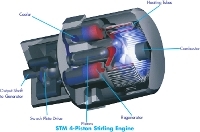I Overview
Stirling engines generate motive or electric power using a cycle driven by an external heat source. This differentiates them from internal combustion engines, which burn fuel within the working fluid.
A portion of the engine is maintained at a constant high temperature, and another portion at a constant low temperature. The working gas is transferred back and forth between the hot and cold portions due to the reciprocating motion of pistons. These pistons are connected to a crankshaft, which in turn drives a generator.
II Applications
Stirling engines are being considered for residential and small commercial power generation systems. Stirling engines can also be used in cryocoolers and solar power generation. A Stirling engine can be installed at the focal point of a parabolic solar reflector, and will use the concentrated solar energy as its heat source. When used as a cryocooler, a Stirling engine acts like a heat pump, and can cool substances to temperatures far below those of conventional coolers. These cryocoolers can achieve temperatures low enough to liquefy air.
III Equipment Options
Stirling engines can use a wide variety of heat sources, including natural gas, biomass, landfill gas, waste process heat, or even concentrated solar energy. They can also be configured to recover their own waste heat in cogeneration systems.
Stirling engines used for power generation are currently available in capacities up to about 50 kW.
IV Resources
1. Equipment Manufacturer Database
V Photo
Credit: STM Power/Stirling Biopower
